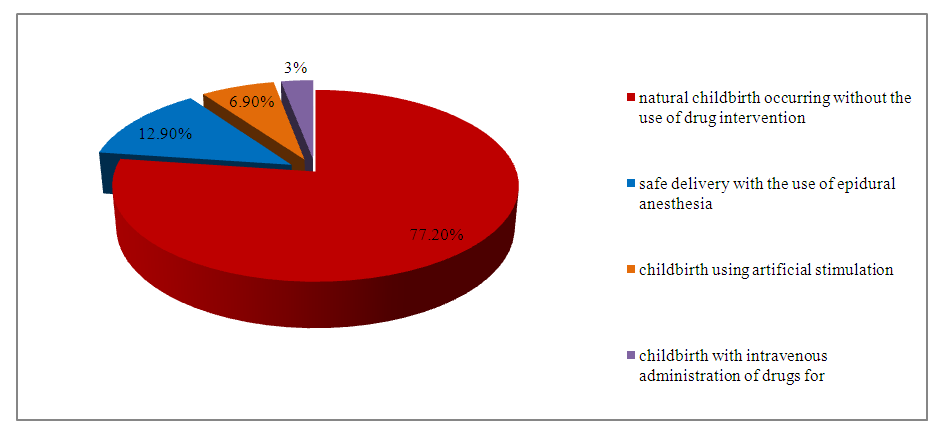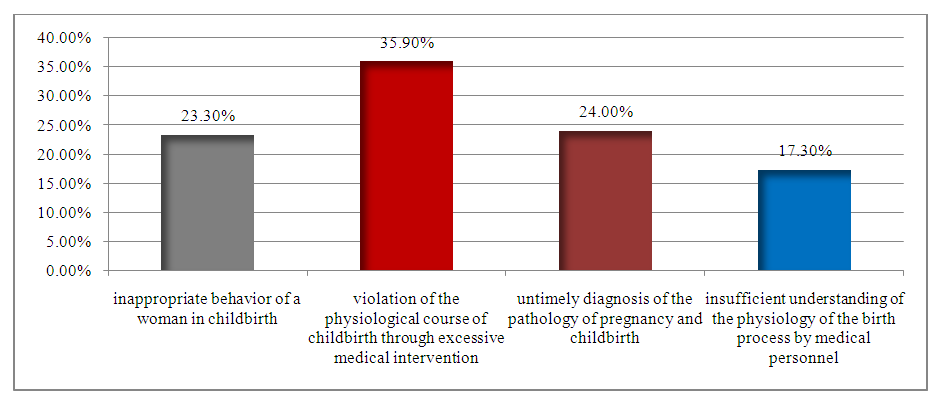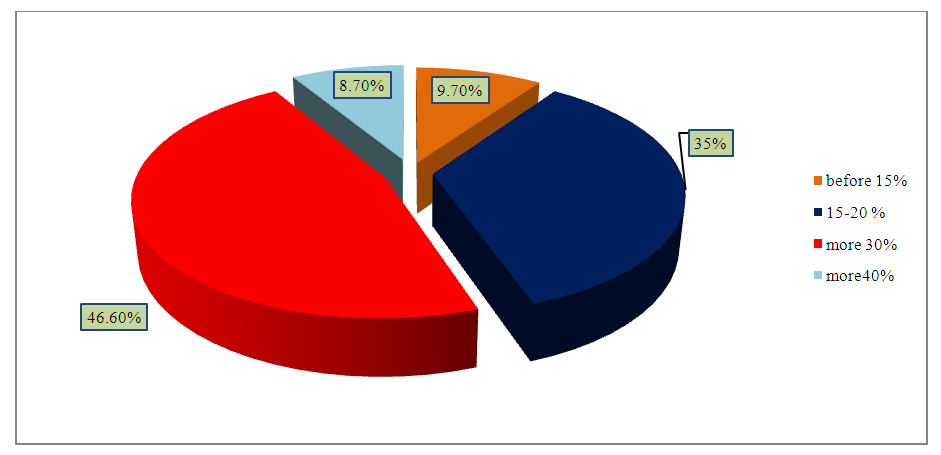-
Paper Information
- Previous Paper
- Paper Submission
-
Journal Information
- About This Journal
- Editorial Board
- Current Issue
- Archive
- Author Guidelines
- Contact Us
American Journal of Medicine and Medical Sciences
p-ISSN: 2165-901X e-ISSN: 2165-9036
2023; 13(12): 2066-2068
doi:10.5923/j.ajmms.20231312.53
Received: Dec. 7, 2023; Accepted: Dec. 27, 2023; Published: Dec. 30, 2023

Caesarean Section During the First Pregnancy: Necessity or Aggression?
Akhmedova Aziza Tayirovna, Rasulova Feruza Golib Kizi, Tursunova Nozanin Nusratovna, Aktamova Nasiba Yuldash Kizi, Mukhitdinova Nigina Anvarovna
Samarkand State Medical University, Uzbekistan
Copyright © 2023 The Author(s). Published by Scientific & Academic Publishing.
This work is licensed under the Creative Commons Attribution International License (CC BY).
http://creativecommons.org/licenses/by/4.0/

According to the data of the UN Statistical Office and WHO recommendations, the optimal age for childbirth is the period of 20-35 years, however, against the background of a decrease in the overall fertility of women in the world, the frequency of pregnancies among young people continues to grow, which is no exception for our region and the country.
Keywords: Cesarean section, Implementation, Antenatal and intranatal, Decrease, Average
Cite this paper: Akhmedova Aziza Tayirovna, Rasulova Feruza Golib Kizi, Tursunova Nozanin Nusratovna, Aktamova Nasiba Yuldash Kizi, Mukhitdinova Nigina Anvarovna, Caesarean Section During the First Pregnancy: Necessity or Aggression?, American Journal of Medicine and Medical Sciences, Vol. 13 No. 12, 2023, pp. 2066-2068. doi: 10.5923/j.ajmms.20231312.53.
1. Introduction
- Cesarean section is a unique measure of preserving the health and life of the mother or fetus, but the global increase in its frequency is alarming [1,2]. In 1990-2014, there was a jump in the frequency of CS in the world from 6.7 to 19.1% (in some countries from 3.1 to 45.8%) with an average annual growth rate of 4.4 (from 0.7 up to 8.5%) [3]. Over the past 10 years, the frequency of CS in Uzbekistan has increased more than 2 times compared to 2005: in 2005 – 250.8 thousand (17.9 per 100 births), in 2016 – 516.1 thousand (28.0 per 100 births) [4].In 1990-2014, there was a jump in the frequency of cesarean section in the world from 6.7 to 19.1% (in some countries from 3.1 to 45.8%) with an average annual growth rate of 4.4 (from 0.7 to 8.5%). The frequency of cesarean section in Uzbekistan is constantly increasing (from 9.58% in 1999 to 16.10% in 2019), which increases the risk of maternal and perinatal morbidity and mortality. That is why the rehabilitation of women after COP is an urgent problem of modern obstetrics, which is of great social importance.The position of the International Federation of Obstetricians and Gynecologists (FIGO), declared in 2018, on possible measures capable of stopping the epidemic of COP, is aimed at stopping the manipulation of the delivery method by commercial interests.According to the data of the UN Statistical Office and WHO recommendations, the optimal age for childbirth is the period of 20-35 years, however, against the background of a decrease in the overall fertility of women in the world, the frequency of pregnancies among young people continues to grow, which is no exception for our region and the country.The high frequency of CS in countries with a high level of development and its almost zero values in countries with a low level of development are alarming signals indicating that the frequent absence of the possibility of delivery in this way can cause an increase in maternal and perinatal morbidity and mortality [5].The position of the International Federation of Obstetricians and Gynecologists (FIGO) declared in 2018 on possible measures capable of stopping the epidemic of COP is aimed at stopping the manipulation of the delivery method by commercial interests [2]. It was proposed to equalize the cost of delivery through the natural birth canal and CS, to regularly publish the frequency of CS in medical institutions of various levels. Absolute indicators of the frequency of CS are faceless in themselves, generically demonstrate its relevance in the world, do not reflect the validity of its implementation. To date, there are no meta-analyses, global studies on the structure of CS with justified indications for it.Unfortunately, most epidemiological studies provide only uniform information reflecting the frequency of multiple CS, the localization of the incision on the uterus, the ratio of antenatal and intranatal CS, etc., which does not allow to properly adapt clinical delivery protocols to the requirements of modern reality, the capabilities of medical institutions at various levels, the resources of a particular country, region.The contradiction in the rationale for choosing the method of delivery, achieving a certain hypothetical "norm" of the frequency of CS is also reflected in the position of the World Health Organization (WHO), presented in 2015, which states that the frequency of CS above 10% at the population level is not associated with a decrease in maternal and perinatal mortality. However, the need to make every effort to provide CS to women in need is emphasized, and not to strive to achieve a certain indicator (WHO, 2015) [10].The purpose of the study: to study the risk factors of cesarean section in first-time mothers. Materials and methods of research. We analyzed n-245 birth histories of primiparous women from 6 districts of the Samarkand region in 2022, who had a caesarean section. The average age of primiparous was 20±3.8 years with fluctuations from 17 to 36 years.After analyzing the medical history, it was revealed that during pregnancy arterial hypertension occurred in 8.30%, kidney disease in 14%, anemia in 76.40%, edema in pregnant women occurred in 12.40%, nausea in early pregnancy in 10.90%.Of the indications for CS, the primiparous had severe preeclampsia in 8.20%, pelvic-head disproportion in 22.40%, inconclusive fetal condition in 26.50%, incorrect fetal position in 32.50%.Among the respondents, the professional work experience in the specialty obstetrician gynecologist averaged 20 years, mainly interviewed doctors with the first and highest categories of professional evaluation.To the question "Which childbirth is the safest, in your opinion?" the majority answered (Fig. 1).To the question "What are the main causes of birth injuries in infants and postpartum complications in women?" (Fig. 3).Also, with an increase in the percentage of delivery by cesarean section, we anonymously asked to answer the question "What is the percentage of abdominal deliveries in your institution?" (Fig. 2).
 | Figure 1. Which childbirth is safe? |
 | Figure 2. What are the main causes of birth injuries in infants and postpartum complications in women? |
 | Figure 3. Indicators of abdominal labor in Samarkand |
2. Conclusions
- Today, it is extremely necessary to assess the frequency of unjustified delivery tactics, namely the frequency of unjustified antenatal CS, unsuccessful attempts at vaginal delivery, the frequency of deliveries with severe complications for the mother and/or newborn. An audit of the frequency of unjustified CS (antenatal and intranatal), taking into account severe complications for the mother and/or fetus, will expand the understanding of the role of CS in maternal and perinatal outcomes.
 Abstract
Abstract Reference
Reference Full-Text PDF
Full-Text PDF Full-text HTML
Full-text HTML